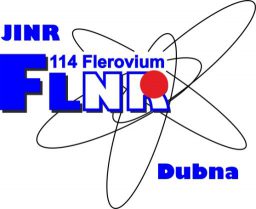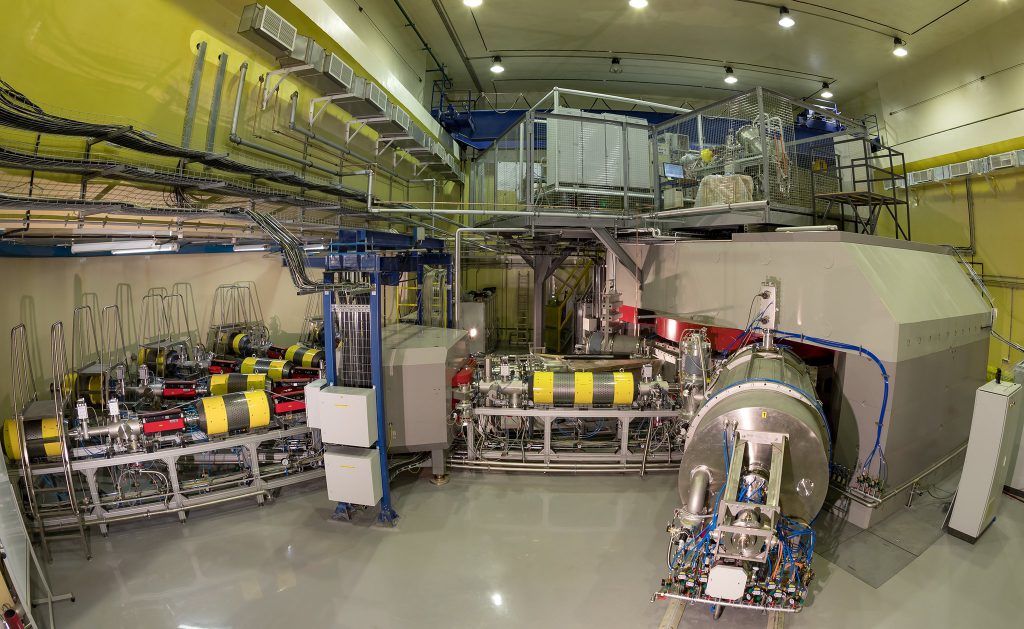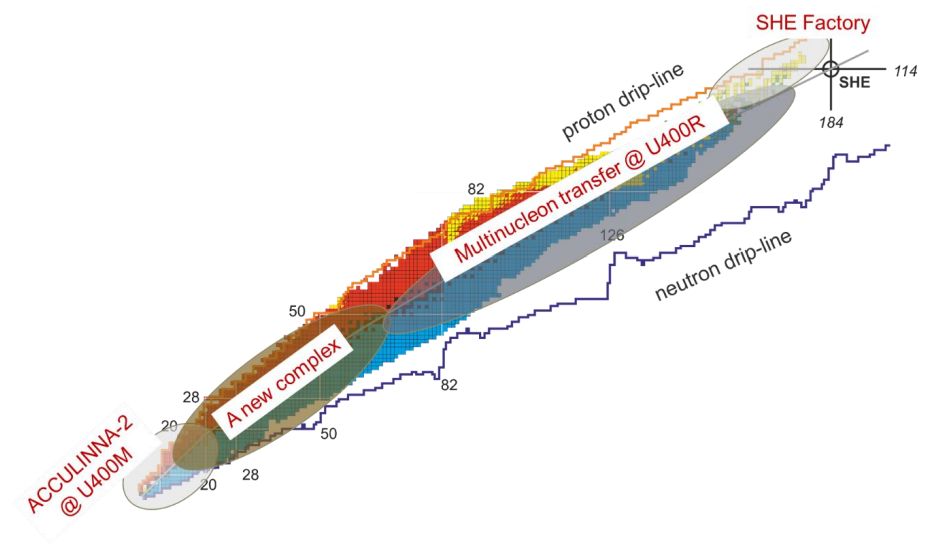FLNR in Seven-year plan for the development of JINR 2024 – 2030
DEVELOPMENT OF A LARGE JINR RESEARCH INFRASTRUCTURE
The Factory of Superheavy Elements, based on a specialized DC-280 cyclotron and equipped with new generation experimental facilities, is the most important component of the DRIBs-III (Dubna Radioactive Ion Beams) project. The full-scale implementation of this project is a priority task for the Flerov Laboratory of Nuclear Reactions for the period 2024–2030, the phased solution of which will significantly expand the possibilities for conducting fundamental and applied nuclear physics research at JINR at the highest level in broad cooperation with scientific centres of the Member States of the Institute and other countries.
In the period 2024–2030, the following is planned:
1. Development of methods for obtaining intense beams of 48Ca, 50Ti, 54Cr, etc.
2. Creation of a new ECR-type ion source operating at a frequency of 28 GHz.
3. Development of a fleet of experimental facilities: launching a cryogenic gas trap, creating a superresolution multi-reflective time-of-flight mass analyzer and a superconducting pre-separator based on a gasfilled solenoid, developing a chemical plant. It is also planned to design a Penning trap and develop laser
spectroscopy methods.
Reconstruction of the U-400 accelerator complex and creation of a new experimental hall. Expanding
the total area of the experimental hall to 1500 m2 with the possibility of autonomous operation in radiationisolated cabins is aimed at creating a new experimental building for the U-400R accelerator. The planned
construction completion date is 2026. At the same time, the reconstruction of the cyclotron will be carried
out, with a focus on:
Plan of the Laboratory of Nuclear Reactions, taking into account the infrastructure facilities planned for construction in 2024–2030
Development of the DC-140 accelerator complex. In 2024—2030, the creation and development of the DC-140 accelerator complex will be continued in terms of reaching the design parameters of beams, as well as equipment for experimental channels. The tasks of the complex are related to research in the field of solid state physics, surface modification of various materials, production of track membranes, as well as testing the radiation resistance of electronic components.
Table 3. The DRIBs-III cyclotron complex(thousand US dollars)
Creation of a radiochemical laboratory of the 1st class. The laboratory will be equipped with a powerful
electron accelerator and will allow working with highly active materials, including:
NUCLEAR PHYSICS
In 2024–2030, the following main areas of research in the field of low-energy nuclear physics will be further developed: the synthesis of superheavy elements in reactions with heavy ions and the study of their nuclear physical and chemical properties, study of the mechanisms of nuclear reactions with heavy ions, study of the structure of nuclei located at the drip lines, basic research with neutrons, as well as applied research.
Synthesis of isotopes of superheavy elements and study of their nuclear physical properties
In 2024–2030, an in-depth study of the nuclear physical properties of isotopes of superheavy elements with Z = 103 ÷ 118 will be performed at the SHE Factory, including first measurements of the masses of heaviest nuclei, determination of the characteristics of their low-lying states, search for rare decay modes, as well as rare reaction channels. Experiments are planned to be performed on the synthesis of new elements with atomic numbers Z = 119 and 120 on 50Ti and/or 54Cr beams. Considerable attention will be paid to experiments on the synthesis of new isotopes of superheavy elements to determine the borders of the “island” of increased stability.
Investigation of the processes of multi-nucleon transfers in collisions of massive nuclei, synthesis of new neutron-rich heavy nuclei
Reactions of multi-nucleon transfers (MNTs) in near-barrier collisions of actinides are a promising method for the synthesis of new neutron-rich isotopes of heavy and superheavy elements. The deeply modernized U-400R accelerator complex, including a new experimental building, will create the necessary conditions for in-depth study of these and other low-energy nuclear reactions with heavy ions. The development and construction of new facilities for the implementation of the FLNR research program for studying nuclear 28 reactions should be carried out in the coming years. The FLNR program in the field of MNTs will be aimed both at studying the mechanisms of these reactions, focused on collecting kinematically complete information about specific reaction channels, and at using MNTs as a method for obtaining and studying new (mainly neutron-enriched) isotopes of heavy and superheavy elements. In the latter case, the facilities should be able to separate and allow the study of long-lived neutron-rich nuclides of elements up to Z = 101–110. The synthesis of these nuclides will also allow conducting chemical studies in liquid phase.
For wide application of multi-nucleon transfer reactions to the synthesis of the heaviest nuclei, highintensity uranium beams are required. The development of a new 28 GHz ECR ion source will be essential to support these studies. The planned experimental study of MNT reactions must be accompanied by the active development of appropriate theoretical approaches.
Nuclear structure of transfermium elements
In 2024–2030, the program for α-, β- and γ-spectroscopy of the heaviest nuclei will continue to be implemented at the upgraded multiparameter detector complex GABRIELA (SHELS velocity selector, U400R accelerator). For the first time, the region of superheavy element isotopes in the island of stability becomes available for nuclear spectroscopy experiments. These experiments will be carried out with the DGFRS-3 separator (GRAND) at the SHE Factory.
Development of the study of SHE chemical properties
Further development of research on the chemical properties of superheavy elements requires a significant increase in the performance of the facility from units to hundredths of a second. For these purposes, a new specialized pre-separator based on a gas-filled solenoid is being created at FLNR. In addition, the development of devices for the transportation and separation of nuclear reaction products, primarily a superconducting solenoid, as well as measurement and recording systems, will continue. At these devices, both “traditional” experiments to study the properties of SHE in the elementary state and the behavior of their chemical compounds will be performed at a new methodological level. Chemical experiments will focus, in particular, on the study of the properties of Nh and Mc. Another important task is to set up the first-ever experiments for Mt, Ds and Rg.
Study of the properties of heavy and superheavy nuclei by precision mass spectrometry and laser spectroscopy
Performance of the world’s first experiments on precision measurement of the masses of superheavy nuclei will require significant development of the experimental base of the SHE Factory. In 2024–2030, it is planned to create a complex that includes the existing gas-filled separator GRAND, a cryogenic gas catcher and a multi-reflection time-of-flight mass analyzer. The task is to measure the masses of superheavy nuclei with a resolution of 106 and higher. The time-of-flight mass spectrometer can serve as the first stage for the Penning trap, which allows the analysis of isotopes by mass with a resolution of ~1010. In addition, in the next seven years we intend to develop methods of ionization laser spectroscopy inside a gas cell, which will allow us to carry out pioneering experiments to determine the first ionization potential of transfermium elements.
Study of the mechanisms of reactions with stable and radioactive nuclei, search for new decay modes
The aim of research with radioactive beams (RIB) is to expand knowledge about the chart of nuclides from nuclear stable isotopes to the limits of the existence of a nuclear structure. Secondary beams of radioactive isotopes far from the stability line will complement the studies of superheavy elements conducted at FLNR.
In the last 2–3 decades, bright results related to the structure of neutron-rich nuclear systems, such as 4–7H, 5–10He and other isotopes located at the borders of nucleon stability, have been obtained at FLNR. A number of new complex experimental approaches and techniques have been developed. In particular, a unique cryogenic tritium target complex has been developed at the Laboratory to populate the low-energy spectra of the nuclei of interest.
The JINR FLNR will ensure the continuation of experimental research in the field of light exotic nuclei located at the borders of nucleon stability, including the study of cluster states, exotic multi-neutron decays, two-proton radioactivity, the search for new magic numbers and spectroscopy of exotic nuclei, reactions with halo nuclei.
FLNR is currently considering two main ways to expand the long-term RIB technology development programme for the next seven years and beyond. The most ambitious, in terms of the scope of the research programme, and, at the same time, the most expensive project involves the construction of a high-precision continuous linear accelerator for producing heavy-ion beams with energies up to 100 A MeV. Such an energy of ion beams with an intensity of 1 μA particles for U and >10 μA particles for lighter nuclei will make it possible to increase the intensity of secondary beams by several orders of magnitude, as well as to produce and study the isotopes most distant from the beta stability line. The E1-E2 project based on a tandem of two cyclotrons, which are under preparation at FLNR, also involves the production of heavy-ion beams with energies up to 100 A MeV.
The third proposal implies the use of the modernized U-400M accelerator as a driver, the primary beam stop in a thick target, extraction of exotic nuclei ions, transport and subsequent pre-acceleration at the U-400R cyclotron. Secondary beams in a wide energy range of 0.8–28 A MeV with an intensity of up to 109 s–1 can be used to study the structure of exotic nuclides in transfer and recharge reactions, search for rare decays with an active target (the project is under development), and study of reactions, which are of interest to astrophysics. The secondary beams will be transported to the new experimental hall of the U-400R cyclotron.
In the next decade, the experimental program on radioactive beams will be implemented mainly with the ACCULINNA-2 fragment separator of the U-400M cyclotron complex, which underwent a deep modernization in 2020–2023. The ACCULINNA-2 separator is equipped with a number of tools, such as a radio-frequency filter for additional purification of secondary beams, a zero-angle spectrometer for separating charged reaction products, a neutron wall based on stilbene crystals, etc. A new cryogenic gas target (hydrogen isotopes, including tritium, and helium) is expected to be commissioned by 2024. The 7- year period includes, in particular, the study of exotic nuclear systems such as 10He, 13Li, 16Be, 7B, 26S, 15Ne in 2n-, 2p-transfer reactions with tritium and 3He targets. Some of these nuclei have already been the subject of research on ACCULINNA-1, 2 separators, which showed the need for additional statistics and improved energy resolution.
Applied research on heavy-ion beams
In 2024–2030, applied research is planned to be developed based on the U-400R, U-400M, DC-140 heavyion accelerators and the MT-25 electron accelerator.
In the field of research on radiation resistance of materials and radiation damage physics, work will be carried out on the study of radiation resistance of nanostructured ceramics, and oxides, high-entropy alloys and dispersed oxide-hardened steels to heavy ions with energies of fission fragments. Particular attention is planned to be paid to the study of the long-term stability of materials of interest for use as target substrates in experiments on the synthesis of superheavy elements.
In the field of track membranes and the creation of new nano- and microstructured functional materials, research will focus on the most in-demand areas related to life sciences, energy-saving technologies and environmental protection. Using hybrid technologies, membranes will be developed for new separation processes, for specific medical and biological applications, and for highly sensitive analysis methods (sensors).
A new generation of sensitization setups for ion-irradiated polymer films and chemical etching setups will be created and put into operation. It is planned to develop a fleet of equipment for comprehensive support of all developments, including methods of elemental analysis, studies of the morphology of materials, physical and mechanical tests, etc.
According to the SEVEN-YEAR PLAN FOR THE DEVELOPMENT OF JINR FOR 2024–2030





